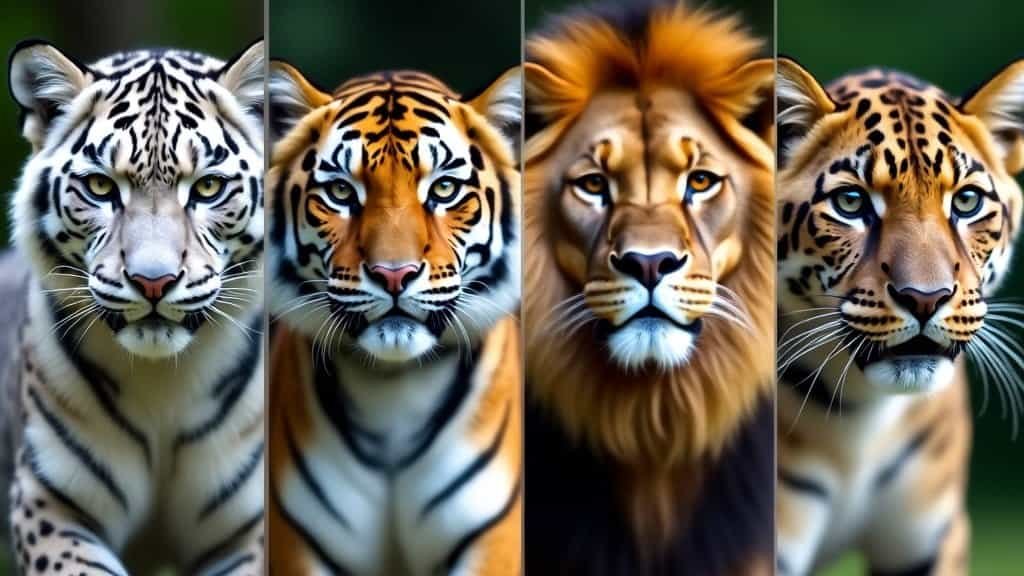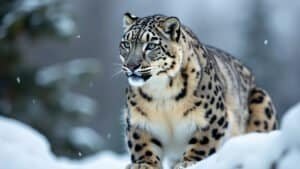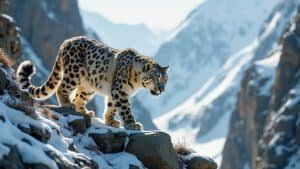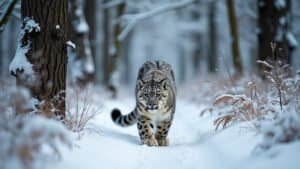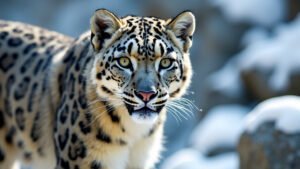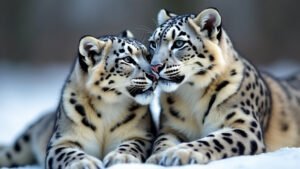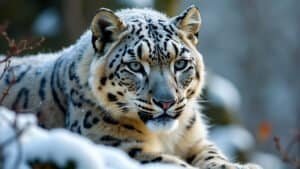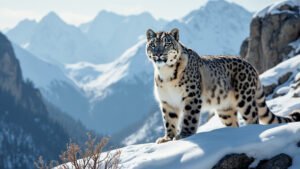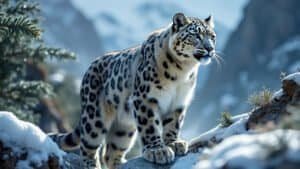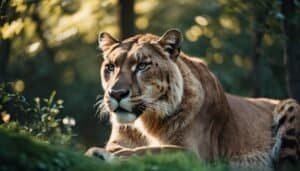Introduction
Snow leopards, known for their elusive nature and stunning appearance, hold a unique position within the evolutionary tree of big cats. This article delves into their scientific classification, genetic relationships with other big cats, and distinctive evolutionary traits
We will explore how snow leopards differ from other members of the Panthera genus, their evolutionary history, and their remarkable adaptations to mountainous habitats. Understanding these aspects is crucial for appreciating the snow leopard’s place in the natural world and the efforts needed to conserve this magnificent species
Scientific Classification of Snow Leopards
The snow leopard, scientifically known as Panthera uncia, is a member of the Felidae family and the Pantherinae subfamily
The Pantherinae subfamily includes all the big cats, such as lions, tigers, leopards, and jaguars. Snow leopards are unique within this group due to their adaptations to high-altitude, mountainous environments
Taxonomy of Snow Leopards
Snow leopards are classified under the genus Panthera, which they share with lions (Panthera leo), tigers (Panthera tigris), leopards (Panthera pardus), and jaguars (Panthera onca). This classification is based on both morphological characteristics and genetic evidence
The genus Panthera is distinguished by features such as a specialized larynx, allowing these cats to produce a range of vocalizations, including the iconic roar. However, snow leopards are an exception in this genus as they cannot roar, instead making a variety of other vocalizations like chuffing and meowing
Genetic Makeup
Genetic studies have provided significant insights into the evolutionary relationships between snow leopards and other big cats. DNA analysis has shown that snow leopards share a close genetic relationship with tigers, more so than with lions, leopards, or jaguars
This relationship suggests that snow leopards and tigers diverged from a common ancestor more recently in evolutionary history compared to their divergence from the other big cats
Research published in the journal Molecular Phylogenetics and Evolution indicates that the split between snow leopards and tigers occurred approximately 3.9 million years ago
Comparison with Other Big Cats
Despite their common genus, snow leopards exhibit several distinct differences from their Panthera relatives. Unlike lions, which are highly social and live in prides, snow leopards are solitary creatures
They are also more closely associated with rugged, high-altitude environments, whereas other big cats, such as leopards and tigers, inhabit diverse habitats ranging from savannas to rainforests
In terms of physical adaptations, snow leopards have developed several unique traits to survive in their harsh, mountainous habitats. These include a thick fur coat, long bushy tail for balance and warmth, and large nasal cavities that help them breathe in the thin, cold air of high altitudes
Their wide, fur-covered paws act like natural snowshoes, enabling them to walk on snow without sinking
Genetic Relationships Among Big Cats
Understanding the genetic relationships among big cats provides insights into their evolutionary history and how species like the snow leopard fit into the broader family tree
This section will delve into the DNA analysis, phylogenetic studies, and the evolutionary divergence of big cats, emphasizing the position of snow leopards
DNA Analysis
Modern genetic techniques have revolutionized our understanding of the relationships among big cats. Through sequencing and comparing the genomes of various species, scientists have been able to map out the genetic distances and common ancestries within the Panthera genus
DNA analysis has revealed that snow leopards (Panthera uncia) share a closer genetic relationship with tigers (Panthera tigris) than with lions, leopards, or jaguars
This close genetic relationship has been substantiated by several studies, including a comprehensive genomic analysis published in Science Advances, which highlighted the relatively recent divergence of snow leopards and tigers from their last common ancestor approximately 3.9 million years ago
Phylogenetic Studies
Phylogenetic studies involve examining the evolutionary relationships among species through their genetic material. For big cats, these studies have constructed detailed phylogenetic trees that illustrate how various species are related and when they diverged from common ancestors. Snow leopards occupy a unique branch on this tree, closely linked to tigers
This relationship is visually represented in the phylogenetic tree, showing a split between the snow leopard-tiger lineage and the lineages leading to lions, leopards, and jaguars. The phylogenetic position of snow leopards has been further confirmed by mitochondrial DNA studies, which have traced maternal lineages and supported the close evolutionary ties with tigers
Evolutionary Divergence
The evolutionary divergence of snow leopards from other big cats is a fascinating aspect of their history. The split from their closest relatives, the tigers, is believed to have been driven by environmental changes and geographical barriers
As the ancestors of snow leopards adapted to colder, high-altitude environments, they evolved distinct physiological and behavioral traits that set them apart from other big cats. This divergence is marked by unique adaptations such as the development of a thick fur coat, enlarged nasal cavities, and powerful limbs suited for climbing and navigating rugged terrain
Fossil evidence also supports the evolutionary divergence of snow leopards. Fossils of Panthera species found in Central Asia, dated to millions of years ago, suggest a long history of adaptation to mountainous habitats. These fossils provide a glimpse into the gradual changes that occurred as the ancestors of modern snow leopards evolved to survive in increasingly challenging environments
Unique Evolutionary Traits of Snow Leopards
Snow leopards have evolved several unique traits that distinguish them from other big cats and allow them to thrive in their mountainous habitats. This section explores their physical adaptations, behavioral characteristics, and ecological niche
Physical Adaptations
Snow leopards are exceptionally well-adapted to their cold, high-altitude environments. Their physical adaptations include:
Thick Fur Coat: Snow leopards possess one of the densest fur coats among big cats, which provides insulation against the freezing temperatures of their mountainous habitats. This coat is patterned with rosettes and spots that offer camouflage against rocky terrains
Long, Bushy Tail: Their tails, which can be as long as their body, serve multiple purposes. They provide balance while navigating steep and rocky slopes and can be wrapped around the body for added warmth during rest
Large Nasal Cavities: Adapted for high altitudes, snow leopards have large nasal cavities that warm the cold air before it reaches their lungs, making breathing easier in thin, cold air
Powerful Limbs and Paws: Their strong, muscular limbs enable them to leap as far as 50 feet in a single bound, crucial for moving across rocky and uneven terrain. Their large, fur-covered paws act like snowshoes, distributing their weight and helping them walk on snow without sinking
Short Muzzle and Broad Forehead: These features allow for a powerful bite, essential for capturing and subduing prey in rugged environments where chases are short but intense
Behavioral Characteristics
Behaviorally, snow leopards exhibit several traits that have evolved to suit their solitary and elusive lifestyle:
Solitary Nature: Unlike lions that live in prides, snow leopards are solitary animals. They establish large territories that they mark with scent markings and scrape marks to ward off other snow leopards
Nocturnal and Crepuscular Activity: Snow leopards are primarily active at dawn, dusk, and night, which helps them avoid human activity and increases their hunting success
Silent Communication: Due to their inability to roar like other big cats, snow leopards rely on other forms of communication, such as chuffing, mewing, and growling. These vocalizations are often used during mating or between a mother and her cubs
Exceptional Stealth: Their coloration and quiet, deliberate movements make them exceptionally good at stalking prey. They can approach within striking distance without being detected
Ecological Niche
Snow leopards occupy a unique ecological niche, shaped by their environment and available prey:
High-Altitude Habitats: They are found in mountainous regions across Central and South Asia, including the Himalayas, the Tibetan Plateau, and the Altai Mountains. These areas range in altitude from 3,000 to 5,500 meters
Diet and Hunting Techniques: Snow leopards are carnivorous and have a varied diet that includes blue sheep, ibex, marmots, pikas, and other small mammals. They are ambush predators, relying on stealth and the element of surprise to capture their prey. Their powerful hind legs allow them to pounce on prey from a distance and drag it over long distances, often uphill, to a safe location for feeding
Territory and Range: Each snow leopard occupies a vast territory that can span up to several hundred square kilometers. The size of their territory is influenced by prey availability and terrain. They use scent markings and vocalizations to communicate boundaries and reduce encounters with other snow leopards
Differences Between Snow Leopards and Other Big Cats
Snow leopards possess several distinguishing characteristics that set them apart from other big cats within the Panthera genus. This section will explore the morphological differences, habitat preferences, and predatory behaviors that make snow leopards unique
Morphological Differences
Snow leopards are distinct from other big cats in several physical ways:
Fur and Coloration: While many big cats have spotted or striped fur, the snow leopard’s fur is particularly thick and covered with large rosettes and spots that provide excellent camouflage against rocky, snowy backgrounds. This coat not only keeps them warm in cold climates but also helps them blend into their environment to avoid detection by prey and potential threats
Tail: The snow leopard’s tail is proportionally longer and more robust than those of other big cats. This tail is used for balance when traversing rugged terrain and can be wrapped around the body for additional warmth during cold weather
Body Size and Build: Snow leopards are smaller and more lightly built compared to tigers or lions but are robust and muscular, adapted for leaping and climbing in mountainous regions. Adult snow leopards weigh between 60 to 120 pounds, whereas other big cats, like tigers, can weigh up to 600 pounds
Facial Structure: Snow leopards have a shorter muzzle and a broad forehead, which allows for a powerful bite. This adaptation is crucial for holding onto prey in difficult terrains where a firm grip is necessary
Habitat Preferences
The habitats of snow leopards contrast sharply with those of other big cats:
Mountainous Regions: Unlike lions and leopards that thrive in savannas and forests, snow leopards inhabit high-altitude mountainous regions across Central and South Asia. These areas are characterized by rugged terrain, steep cliffs, and sparse vegetation, which provide the cover and vantage points necessary for hunting
Altitude Adaptation: Snow leopards are adapted to live at altitudes ranging from 3,000 to 5,500 meters. This adaptation includes physiological traits such as larger nasal passages and chest cavities that enhance oxygen intake and circulation in low-oxygen environments
Climate: While many big cats live in warmer climates, snow leopards are adapted to cold, harsh environments with extreme temperature variations. Their dense fur and thick skin provide necessary insulation against the cold
Predatory Behaviors
The predatory strategies of snow leopards also set them apart:
Ambush Hunting: Snow leopards rely heavily on stealth and ambush tactics to catch their prey. They use the rocky terrain to their advantage, often lying in wait or stalking prey with great patience. Their powerful hind legs enable them to leap across large distances to pounce on unsuspecting prey
Diet: Snow leopards primarily hunt ungulates such as blue sheep (bharal) and ibex. They also prey on smaller mammals like marmots and pikas. This diet differs from that of lions, which primarily hunt large herbivores like zebras and wildebeests, and tigers, which often prey on large ungulates like deer and wild boar
Feeding Habits: After a successful hunt, snow leopards will often drag their kill to a secluded spot, sometimes uphill, to feed. This behavior contrasts with the more social feeding habits of lions, which consume their prey where it falls, often sharing with pride members
Evolutionary History of the Panthera Genus
The evolutionary history of the Panthera genus provides crucial insights into how snow leopards and other big cats have diverged and adapted to their respective environments
This section will discuss the origin and divergence of the Panthera genus, fossil records, and the ancestral lineage of snow leopards
Origin and Divergence
The Panthera genus is believed to have originated in Asia around 6 to 10 million years ago. This genus includes some of the most well-known big cats: lions, tigers, leopards, jaguars, and snow leopards
The evolutionary history of this group is marked by significant divergences driven by geographic isolation and environmental changes:
Panthera Lineage: Genetic studies suggest that the common ancestor of the Panthera species lived in Asia. From this ancestor, the various species diverged over millions of years. The snow leopard and tiger share a more recent common ancestor compared to other Panthera species
This divergence occurred approximately 3.9 million years ago, likely due to adaptations to different ecological niches—snow leopards adapted to cold, mountainous regions, while tigers adapted to dense forests and grasslands
Environmental Pressures: The diversification of the Panthera genus was influenced by climatic changes and the movement of tectonic plates, which created new habitats and isolated populations. These changes forced species to adapt to new environments, leading to the distinct evolutionary paths observed today
Fossil Records
Fossil evidence provides a tangible record of the evolutionary history of the Panthera genus. Fossils of big cats have been found in various parts of Asia, Europe, and North America, offering insights into their historical distribution and adaptation:
Early Fossils: The oldest known Panthera fossils date back to the late Miocene epoch, approximately 5 to 10 million years ago. These fossils suggest that early Panthera species were already large, powerful predators
Fossil remains of Panthera blytheae, discovered in the Himalayas and dated to about 4.1 to 5.9 million years ago, are considered one of the earliest known members of the genus
Snow Leopard Ancestors: Fossils specifically attributed to the lineage leading to modern snow leopards have been found in Central Asia. These fossils indicate that ancestral snow leopards inhabited high-altitude regions long before the emergence of the modern species
The adaptations seen in these fossils, such as robust limbs and specialized teeth, reflect the harsh environments they lived in
Ancestral Lineage
The ancestral lineage of snow leopards reveals a history of adaptation and survival in some of the world’s most challenging habitats:
Genetic Heritage: Modern genetic analysis has traced the lineage of snow leopards back to a common ancestor shared with tigers. This lineage split from the other Panthera species approximately 3.9 million years ago
The genetic similarities between snow leopards and tigers include specific adaptations for powerful hunting and survival in diverse environments
Evolutionary Adaptations: As the snow leopard lineage diverged from that of tigers, they developed unique adaptations to survive in mountainous regions. These adaptations include physical traits like a thick fur coat and large nasal passages, as well as behavioral traits such as solitary hunting and territoriality
Geographic Distribution: The historical range of snow leopard ancestors likely extended across much of Central Asia. Over time, climatic changes and the rise of the Himalayan mountain range further isolated these populations, leading to the distinct species we see today
Adaptations to Mountainous Habitats
Snow leopards have evolved a series of remarkable adaptations that allow them to survive and thrive in the harsh, high-altitude environments of mountainous regions. This section will discuss their physiological adaptations, survival strategies, and reproductive behaviors
Physiological Adaptations
Snow leopards possess several physiological traits that enable them to cope with the extreme conditions of their habitat:
Thick Fur: Their dense, woolly fur, which is among the thickest of any cat species, provides insulation against the cold. The fur is also covered with a layer of longer, coarse guard hairs that help repel moisture and wind
Wide Paws: Snow leopards have large, wide paws that act like snowshoes, distributing their weight over a larger surface area to prevent sinking into the snow. These paws are also covered with fur to provide additional insulation and grip
Large Nasal Cavities: Adapted to high altitudes, snow leopards have enlarged nasal cavities that warm the cold air before it reaches their lungs. This adaptation is crucial for breathing in the thin air found at high elevations
Powerful Limbs: Their short forelimbs and long hind limbs are exceptionally strong, allowing them to leap up to 50 feet in a single bound. This powerful leap is essential for navigating the rocky, uneven terrain of their mountainous environment
Tail: Their long, thick tail provides balance when moving across steep and rugged terrain. It also serves as a blanket, helping to keep them warm when curled around their body during rest
Survival Strategies
Surviving in the mountainous regions requires specific strategies that snow leopards have mastered:
Camouflage: The snow leopard’s spotted coat provides excellent camouflage against the rocky and snowy backgrounds of their habitat. This natural disguise helps them avoid detection by both prey and potential threats
Solitary Lifestyle: Snow leopards are solitary animals, which helps reduce competition for scarce resources. Each individual maintains a large territory, marked with scent markings and scrape marks to communicate boundaries to other snow leopards
Hunting Techniques: Snow leopards are ambush predators. They use their stealth and camouflage to get close to their prey before launching a surprise attack. Their powerful limbs allow them to leap and capture prey with precision
Dietary Flexibility: While their primary prey includes large ungulates like blue sheep and ibex, snow leopards are opportunistic feeders. They will also hunt smaller mammals, birds, and even scavenge carrion if necessary
Reproductive Behaviors
Reproductive behaviors of snow leopards are adapted to ensure the survival of their species in challenging environments:
Breeding Season: Snow leopards typically mate between January and March. During this time, males and females come together briefly for mating, after which they return to their solitary lives
Gestation and Birth: The gestation period lasts about 90 to 100 days, with cubs being born between June and July. Snow leopards usually give birth to 1-3 cubs, though litters of up to 5 cubs have been recorded. Cubs are born blind and rely entirely on their mother for warmth, nourishment, and protection
Parental Care: The mother is solely responsible for raising the cubs. She provides food and teaches them essential survival skills, such as hunting and navigating their terrain. Cubs stay with their mother for about 18-22 months before becoming independent
Cub Development: During their time with their mother, cubs develop the skills needed to survive on their own. They learn to hunt by observing and practicing under the mother’s guidance. By the time they leave, they are proficient hunters, capable of fending for themselves
Conclusion
Snow leopards hold a unique and fascinating place within the evolutionary tree of big cats. Their scientific classification within the Panthera genus, close genetic relationship with tigers, and distinct evolutionary traits highlight their remarkable adaptation to high-altitude environments
Snow leopards’ thick fur, large nasal cavities, powerful limbs, and solitary behaviors have enabled them to thrive in some of the world’s most challenging habitats. Understanding their evolutionary history, from their divergence from a common ancestor shared with tigers to their specialized adaptations for mountainous regions, sheds light on the incredible journey of this elusive big cat
Conservation efforts are crucial to preserving the genetic diversity and ecological niche of snow leopards, ensuring that these magnificent creatures continue to roam the mountains for generations to come
